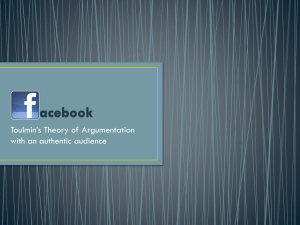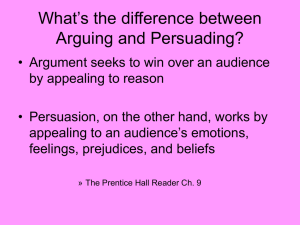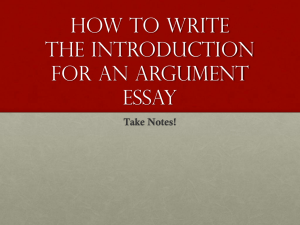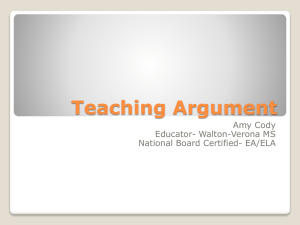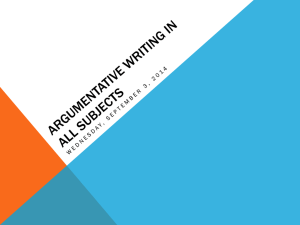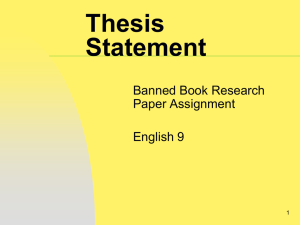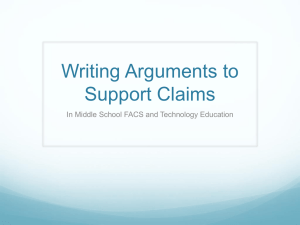Argument - ELORA by National
advertisement
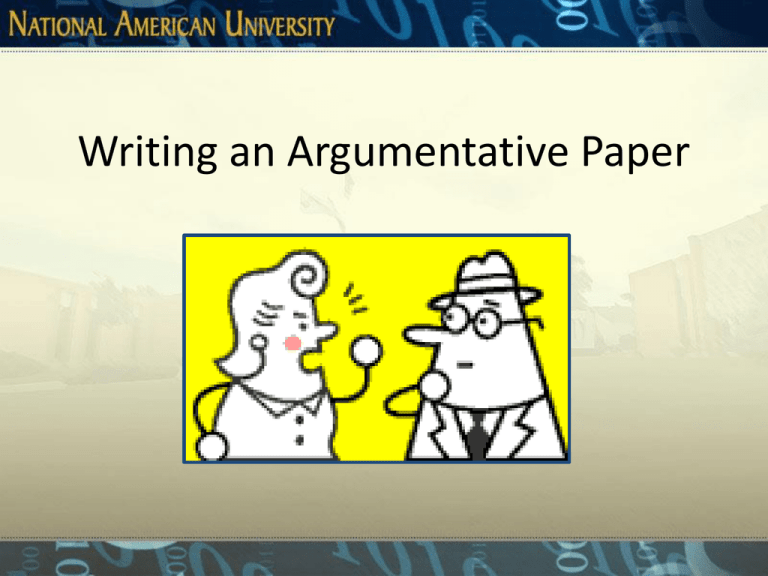
Writing an Argumentative Paper What is an Argument • An argument involves the process of establishing a claim and then proving it with the use of logical reasoning, examples, and research What is Logical Reasoning Drawing conclusions based on a given set of facts Example: Mary and Dave are currently married to each other and have a marriage license, therefor Mary must be Dave’s wife Building a Convincing Argument • Research the topic…become and expert on both the Pros and Cons of the argument • This demonstrates your credibility as a writer— that you have researched multiple sides of the argument and have come to an informed decision • It shows you have considered other points of view - that other points of view are valid and reasonable but not necessarily the best way to address the issue Building a Convincing Argument Cont. • Consider your audience when you offer a counterargument • Conceding to some of your opposition’s concerns can demonstrate respect for their opinions • Remain tactful yet firm. Using rude or deprecating language can cause your audience to reject your position without carefully considering your claims • Organize your argument and research Why is Organization Important in an Argument • Guides an audience through your reasoning process • Offers a clear explanation of each argued point • Demonstrates the credibility of the writer The Organization Patterns • Argumentative Papers have PROs and CONs. • Decide which of the following patterns will be the most suitable for your topic Patterns Pattern # 1 Thesis Statement PRO idea 1 PRO idea 2 CON(s) + Refutation(s) Conclusion Pattern # 2 Thesis Statement CON(s) + Refutation(s) PRO idea 1 PRO idea 2 Conclusion Patterns Pattern #3: Thesis CON idea 1---> Ref. CON idea 2---> Ref. CON idea 3--->Ref. Conclusion Parts of Paper • Information, (other than parts 1, 6, and 7), may be ordered in several ways depending upon the topic and purpose of your argument: – Part 1: Introduction to issue (includes Thesis Statement and attention getter) – Part 2: History of issue, any past attempts at solutions (cite juried/refereed sources) Parts of Paper cont. • Part 3: Extent of the issue and who is affected (cite juried/refereed sources) • Part 4: repercussions if issues not resolved, use (juried/refereed sources) • Part 5: prior paragraphs should have provided sound reasoning, now the argument along with the facts need to be pulled together (if objections, make concessions if necessary) Parts of Paper cont. • Part 6: conclusion (a restating of thesis and summary of the main ideas) • Part 7: references Specifics Intro & Hook Body References Thesis Statement Conclusion Title Title • Often too understated • Introduces issues of discussion to the audience • Generates reader interest in the argument • Create a provocative image to grab the audience’s attention or pose questions • Do NOT choose a title that is too general, lacks character, does not interest you, or one that is not arguable Example Imagine you just wrote a paper offering solutions to the problem of road rage. Which do you consider to be the best title? Road Rage Can’t Drive 55 Road Rage: Curing Our Highway Epidemic Correct Introduction • • • • • Readers first impression of paper Sets stage for rest of paper Includes an Attention getter Includes the Thesis statement General introduction of issues Attention Getter • Impresses reader • Captures their imagination • Leads to a desire to read more • Suggestions: ask a question about the topic, entice the reader with a generalized statement related to the topic such as (hair regrowth products can cause insecurity in some men) or compare and contrast a couple of main points Thesis Statement • The MOST IMPORTANT SENTENCE or sentences in your paper • Expresses your interpretation of the topic and answers the question: “what am I trying to prove” • Not a factual statement, but a claim that has to be proven throughout the paper Thesis Practice: Fact versus Claim Which thesis statement is most effective for an argument about the need for V-chips in television sets? • Parents, often too busy to watch television with their families, can monitor their children’s viewing habits with the aid of the V-chip. • This paper will describe a V-chip and examine the uses of the V-chip in American-made television sets. • To help parents monitor their children’s viewing habits, the V-chip should be required feature for television sets sold in the U.S. Correct General Introduction of Issues • Sets the tone of the paper • Attracts the reader’s attention • Introduces research, theme, and argument Body of Paper • Contains reliable resources and unquestionable evidence with support for both sides • Develop a solid base upon which to build an argument and present your case • Persuasive presentation using persuasive tone balanced with boldness and confidence, (the best way to write persuasively is to write about a topic that you are very familiar with, have an interest in, and has both PROs and CONs) Body of Paper Cont. • Persuasive and powerful language, (think about the language used in court situations on TV, and what the lawyers say to win the case) • Strong evidence usually proves their case • Lack of evidence usually gets the case thrown out Conclusion • Your conclusion should reemphasize the main points made in your paper • You may choose to reiterate a call to action or speculate on the future of your topic, when appropriate • Avoid raising new claims in your conclusion Tips • Remember your goal is to win the argument or sway readers to your point of view • To win the argument you will need to be a expert on the topic • To become an expert you will need to do a lot of research • Don’t waste your time researching un-reliable sources Things to Avoid • Feelings, emotional arguments (… it makes one feel much better) • Irrelevant examples (wandering off the topic) (… he would then be able to take his girlfriend to expensive restaurants) • Oversimplification (… only then would he understand what it means to be an adult) Things to Avoid Cont. • Hasty generalizations (... it is a widely known fact that all adolescents look forward to earning money) • Unreliable, even false outside sources (… according to www.doubtme.com, 80% of working men wish they quit school when they were at university and started working at an earlier age) Things to Avoid Cont. • Arguments that you can’t win • Using First Person Instead of saying “I believe we should support the removal of federal funding in school lunch programs,” use “removing federal funding from our school lunch programs will allow local school systems greater control over what foods are offered to students” Research used in the Paper • On of the MOST important parts of an argumentative paper is that it has a quantity of research, from juried/refereed sites, to substantiate the paper’s main points • Researched material can aid you in proving the claims of your argument and disproving oppositional claims • Be sure to use your research to support the claims made in your topic sentences--make your research work to prove your argument

